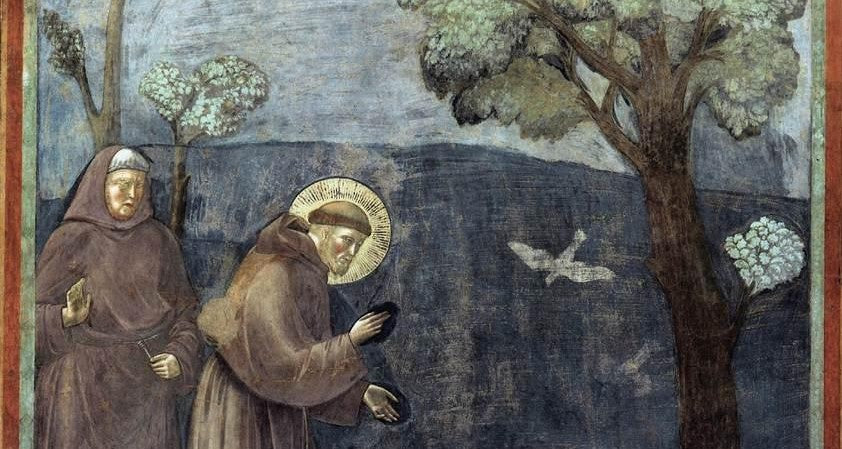
Giotto's Sermon to the Birds
Alice PettirossoShare
The Silent Revolution That Changed Art
Between 1290 and 1300, Giotto di Bondone created a scene that seems simple but that will forever mark Western art: Sermon to the Birds , part of the fresco cycle of the Upper Basilica of San Francesco in Assisi . The work is not only a tribute to the life of the saint of Assisi, but a true visual and narrative revolution, which transforms a religious scene into a moment of profound humanity and spirituality.
In an era dominated by rigid figures and abstract symbols, Giotto breaks the mold and invites us to observe reality with a new gaze. Saint Francis, depicted while preaching sweetly to the birds, is no longer just a Christian icon: he is a man in perfect harmony with nature , a messenger of a love that transcends the boundaries of the human to embrace the whole of creation. In an era characterized by a severe, apparently immutable iconography, Giotto introduces for the first time a palpable visual humanity , thus anticipating the revolution of the Renaissance by decades.
Spirituality, now, is no longer a distant or abstract concept, but something deeply rooted in everyday life, in nature and in the living beings that surround us. It is this ability of Giotto to tell a universal story with few elements, but with an extraordinary force, that consecrates him as a precursor of the great Renaissance masters, including Masaccio and Piero della Francesca.
Extraordinary simplicity: the structure of the work
The strength of the Sermon to the Birds lies in its apparent simplicity. At the center of the scene, the serene and collected figure of Saint Francis dominates the space. The saint is not depicted as a distant authority, but as an empathetic and humanized person, and is dressed in his usual brown Franciscan tunic. In front of him, the birds seem to listen attentively, as if they understand his message. They are no longer decorative elements, but become true protagonists.
The scene, though sober, is vibrant with life. An essential and realistic landscape, with few rocks and trees, frames the event in an atmosphere of quiet contemplation. The Franciscan message of poverty and communion with nature is reflected not only in the figures, but also in the surrounding environment: every detail is functional to strengthen the deep bond between man and creation.
The arrangement of the elements is harmoniously balanced. Saint Francis and his feathered interlocutors are the fulcrum of the composition, but the serenity that radiates from the scene goes beyond the boundaries of the painting, evoking a timeless dialogue between the saint and nature.
PRE-ORDER A COPY FOR YOUR HOME
Silent Innovation: Giotto's Technique
Giotto is famous for breaking the rigid conventions of Byzantine art, and the Sermon to the Birds is a prime example. The figures are no longer two-dimensional and stylized as in rigid medieval iconography, but seem to live, breathe, and occupy space. Saint Francis, with his lifelike proportions and tangible physical presence, almost seems to be able to step out of the fresco and address us.
Even the birds, despite their simplicity, are drawn with a hint of perspective and depth that makes the scene vivid and dynamic. Although Giotto does not yet have the scientific instruments that Renaissance painters will use, his attention to volume and three-dimensionality marks a radical break with the past. This bold choice not only gives the figures a sense of reality never seen before, but lays the foundations for the future of European art.
The colors are soft but evocative: earthy tones that recall Franciscan frugality. The brushstrokes are delicate, but give volume and depth to each figure. The innovative use of color and three-dimensionality allows Giotto to narrate not only through the figures, but also through the atmosphere that surrounds them, making the entire scene, and not just the main subjects, become the protagonist of the painting.
Details that speak: curiosities about the work
Behind the linearity of the Sermon to the Birds lies a complexity of meaning that has fascinated scholars for centuries. What may seem like a scene devoid of action is actually full of symbolism: St. Francis' love for all living creatures is not only an act of tenderness , but a powerful spiritual message that reflects the essence of his teaching.
The fresco cycle of which the work is part was commissioned by the Franciscans both to celebrate the life of their founder and to spread a message of spiritual renewal in a period of profound social and religious change. Giotto, with his unique sensitivity, was able to translate the message into images.
Giotto's frescoes inspired generations of artists , including Masaccio and Piero della Francesca, who found in his pictorial solutions a revolutionary model to follow. His influence has thus spanned the centuries, redefining the way in which Western art would represent reality.

